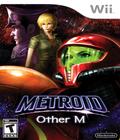WP: Who has the honor to speak with us? State your name, rank and occupation!
I'm Nate Bihldorff, and I'm localization producer at Nintendo of America.
WP: Metroid: Other M is a little bit of a throwback because it ties in as a sequel after Super Metroid rather than the Metroid Prime games. How do the Metroid Prime games relate? Do they happen after this, or do they belong in a separate timeline altogether?
NB: I think the Metroid Prime games exist on their own timeline. This game is very clearly married to the 2-D Metroid timeline. It starts out with a flash back to the end of Super Metroid, which, of course, continued the plot of the original Metroid and Metroid 2. Some indeterminate amount of time passes, and then we have the events in this game. It's set between Super Metroid and Metroid Fusion, specifically because in Metroid Fusion, you basically hear about Adam Malkovich's death and Adam Malkovich is alive in this game, so it's somewhere in that time period between the two.
WP: In working on the localization, you're focusing on bringing the game to the U.S. and making sure that the script has been translated well, but beyond that, what goes into localizing a game like this?
NB: It starts out really early, especially with a game this voice-intensive. There's the real basic stuff, which is the copyright screen — hey, that has to be in English! — but for a game with this much voice, you start really early with the casting. Obviously, we wanted to get voice actors that really fit with the creator's image of who Samus was and the rest of the actors as well. Early on, lots of auditioning, then lots of studio time, doing all the recording. Many, many sessions — you know, as the game gets developed, you keep on adding more and more sessions. Then you get into the real grunt work of actually doing the text and stuff like that. Once you get the text in the game, it's crucial to play through it as many times as you can to make sure that you can actually see that everything you have there is appropriate and giving the right amount of hints to people. You want a wide range of people to be playing it, so you need to be giving hints for those people who aren't really as good at the game and yet still not turn off the people who are Metroid veterans and have played every game in the series. It's kind of a balancing act, but with enough time, you can fine-tune all the text.
WP: Since you're at Nintendo of America and not being involved directly on the development side of things, what was your initial reaction as a Metroid player when you heard about this title?
NB: Oh, I was ecstatic. Anytime I get more Metroid in my life is a good day. I've always been fascinated with the backstory of Samus as well, and when we found out that this game was really going to be exploring a lot of it, I was ecstatic. There's always clearly been a story to be told there. We've always known that she was orphaned and that her parents were killed by space pirates, but that was about the extent of it outside of some minor story dalliances. Knowing that we were going to get a much more plot-intensive one, as a Metroid fan, I was ecstatic.
WP: Metroid: Other M pulls back a little bit from the full 3-D of the Metroid Prime series and moves into sort of 2.5-D. Control-wise, it's almost more inspired by the classic games in the series: Metroid, Super Metroid and Metroid Fusion. What type of balancing issues do you get when you're trying to get 2-D gameplay into the 3-D aspect?
NB: That's a good question and one that I'm sure the level designers and the programmers are constantly struggling with. I think they've managed to walk a very fine line quite well because you're right. You want to preserve the sense of a 2-D Metroid and the sense of exploration and of seeing an area that you want to get to but not quite being able to get there. With this sort of new hybrid gameplay, at any given time, a person can be exploring a 3-D environment and then go into first-person [view] and look around the entire thing. Try to imagine Super Metroid if you could all of a sudden just swivel around, look at a wall and see where you can use a Morph Ball.
I'm sure there are a lot of design decisions that go into that, where they're hiding ducts that only are going to be seen when you go into 3-D. They really want to encourage the player to explore their environment in classic style as much as they can, and then when they bump into an area where, "Hmm, something's a little off here," you go into first-person [view], take a look around, see if anything grabs your interest, and then explore further. Yeah, it's a mighty game design challenge, but as far as I can tell, they're knocking it out of the park.
WP: We've gotten a short demo, looked at the intro, and got some hands-on time with the gameplay and controls. You've obviously had a bit more time with it. From your perspective, what's going to be the biggest challenge that a gamer's going to have when he first sits down? If a gamer has just finished the Metroid Prime triple pack, what's going to be the adjustment level?
NB: It's a whole new game, basically. Whatever camp you're coming from, if you're someone who only played the 2-D games or someone who was weaned on the 3-D ones, either way, it's going to be an entirely new experience — and a great one, once you get used to it. As with any new thing, it takes you a little bit of time before you're [proficient].
You really see Team Ninja's influence when you get into the close-quarters moves, where you're doing a lot of dodging and come up shooting and a lot of the very stylish fighting. The first couple of times people do that, they're probably going to get their butts kicked. It's a new Metroid experience, and you're probably going to be trying to do something that's not going to work as well as what you should be doing. With that said, even over the course of this very short demo, pretty much everybody that I've seen play it, by the end, they're sort of kicking all kinds of ass. (laughs)
WP: The demo was about 45 minutes to an hour of gameplay, which covered the intro mission. What would you estimate is the length of the entire game? Is it about the length of Metroid Prime 3?
NB: I'm not touching that one with a 10-foot pole. (laughs) It'll definitely be a long game, and it'll certainly be the most plot-driven game of the entire series, so you can expect a lot of twists and turns and big surprises.
WP: With Adam Malkovich appearing, there are obviously references back to prior games. Without spoiling anything, can we expect to see other cameos or shout-outs that fans will recognize? For instance, in Super Metroid, the animals were very popular.
NB: I'm not going to speak to anything specifically, but I wouldn't be surprised, frankly, to see a bunch of that stuff. You've got to remember that Mr. Sakamoto, the daddy of the series, is at the helm of this, and it really is clearly drawing on all the other games in terms of where the series has come from and the entire history of it. I definitely think that players will see a lot of familiar stuff.
WP: For a while, it seemed like a lot of game developers, including Nintendo, was on the 3-D bandwagon for sales figures. Even though the hardcore gamers wanted 2-D, the sales figures showed that more people bought 3-D games. With the advent of Xbox Live, PlayStation Network and WiiWare, the downloadable games had a 2-D resurgence and 2-D is becoming acceptable again. What was the culture like inside Nintendo when it was announced that you wanted to release a major title that really plays in 2-D? Could this game have happened two or three years ago?
NB: I think it could have happened. To be honest, I think this one sort of operated outside the whole 2-D resurgence just because the controls are so different. That's really only one component of it. The beauty of the NES control style is not so much that you're doing 2-D platforming, but that it's simple. It's simple gameplay and yet really scratches that itch inside all of us classic gamers, who just want to run and jump as Samus and shoot things. That type of game and that type of level design is clearly something that Sakamoto-san and his team have completely mastered, but then you start getting into these other things, like the first-person view, and you probably saw the section of the demo where it sort of pulls back and it's right over Samus' shoulder and she walks very, very slowly. There are areas like that, too, where you're just sort of exploring and looking around, not in the first person but also not in the pulled-back third-person. This is more of an over-the-shoulder view. There's just a lot going on there, so while I think that the 2-D resurgence, which I'd like to go on record to say that I fully support, has been going on in the background, I think that this game really evolved independent of it.
WP: If you had to sum it up in two to three sentences, what really makes Metroid: Other M a game that's worth playing?
NB: Well, first and foremost, it's the fruit of what I think is a developer match made in heaven. I think that having Sakamoto-san and his team teamed up with the very talented guys at Team Ninja has produced this hybrid game that really takes the best of both of those teams and mashes them together. You have incredible level design combined with really awesome action scenes. That, more than anything else, is really what I think is the defining part of this game. On top of that, from a very old-school Metroid guy, this feels like Metroid, and that should be enough for any Metroid fan. You know what you're going to get going into it; you're going to be blasting tons of aliens, you're going to be exploring all kinds of dark, crazy areas and retraversing them and finding new paths. With the new control scheme, you're going to be doing it in a way that you've never really done it before. It's going to be good, and it's going to catch a lot of people by surprise, especially since, to complement all that gameplay, you have a story line that's just so much further in depth than anything that we've ever gotten in the universe for Metroid. If you're a fan of the series, you will just love it.
WP: Do you have an official release date yet?
NB: It's coming out on June 27 in North America.
WP: Any rumors at all of a demo?
NB: I do not know. Sorry! (laughs)
WP: Is there anything about the game that we haven't talked about that you wanted to add?
NB: No, I think that pretty much covers it. It's going to be awesome.
More articles about Metroid: Other M











 Metroid: Other M looks at the classic franchise from a new perspective: While much of the game is reminiscent of 2-D side-scrollers, players can switch the perspective into 3-D at any time as they explore the twisting passages of a derelict space station and delve deep into a cinematic, never-before-told story of bounty hunter Samus Aran's past.
Metroid: Other M looks at the classic franchise from a new perspective: While much of the game is reminiscent of 2-D side-scrollers, players can switch the perspective into 3-D at any time as they explore the twisting passages of a derelict space station and delve deep into a cinematic, never-before-told story of bounty hunter Samus Aran's past.